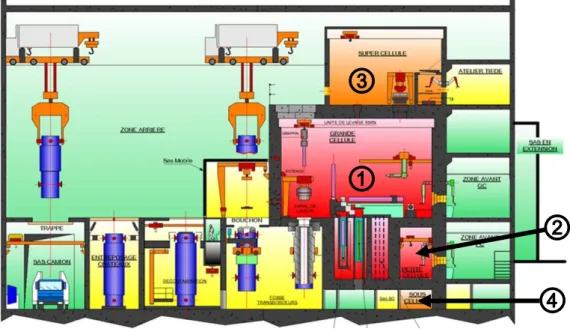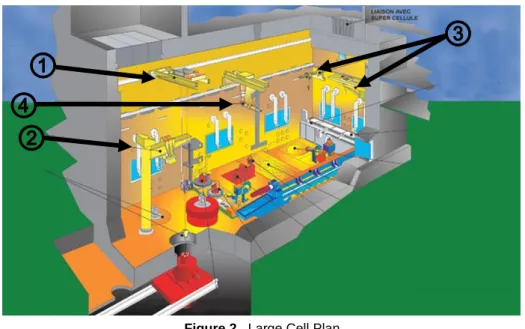HAL Id: cea-02973280
https://hal-cea.archives-ouvertes.fr/cea-02973280
Submitted on 21 Oct 2020
HAL is a multi-disciplinary open access
archive for the deposit and dissemination of
sci-entific research documents, whether they are
pub-lished or not. The documents may come from
teaching and research institutions in France or
abroad, or from public or private research centers.
L’archive ouverte pluridisciplinaire HAL, est
destinée au dépôt et à la diffusion de documents
scientifiques de niveau recherche, publiés ou non,
émanant des établissements d’enseignement et de
recherche français ou étrangers, des laboratoires
publics ou privés.
Refurbishment of a Nuclear Facility in operation : Focus
on the check and thorough maintenance of hot cell’s
handling equipment
P. Gruber, L. Bruguiere, J.-M. Idasiak
To cite this version:
P. Gruber, L. Bruguiere, J.-M. Idasiak. Refurbishment of a Nuclear Facility in operation : Focus on
the check and thorough maintenance of hot cell’s handling equipment. HotLab 2019 - 56th Annual
Meeting on Hot Laboratories and Remote Handling Working Group, Sep 2019, Mamallapuram, India.
�cea-02973280�
Refurbishment of a Nuclear Facility in operation :
Focus on the check and thorough maintenance of hot
cell’s handling equipment
GRUBER Philippe1,BRUGUIERE Lionel1 & IDASIAK Jean-Marc1
1
French Alternative Energies and Atomic Energy Commission, Nuclear Energy Dision,
CEA Marcoule – Installation de Surveillance des Assemblages Irradiés, Bagnols sur Cèze, France
Context
ISAI Facility (Irradiated Assemblies Monitoring Installation) is a nuclear facility at CEA Marcoule in south of France. It was built between 1979 and 1989 with its operation beginning in 1989 and was developed in order to focus on the study of fast breeder fuel pins of SuperPhenix Reactor which are high dimensions (~6m). That’s why it is formed of two hot cells whose one has particularly high dimension (length 13 m, width 6 m and height 9 m).
Today ISAI is a part of the CEA strategy for Civil Spent Fuels as an assembly dismantling and pins containerization facility needed for many years. For this reason, CEA launched refurbishment program at the following of the ISAI’s safety reassessment by the French nuclear regulator. A part of ventilation works required a stop in the spent fuel evacuation program of ISAI and CEA used this time to do an in-depth maintenance on hot cell’s handling equipment with humans inside the hot cells.
The aim of this presentation is to present the feedback on the handling equipment refurbishment, using a 9 meters high scaffold in a hot cell, after twenty-five years operations without any maintenance for certain part impossible to remove, unreachable because of the irradiation and contamination risks...
ISAI Missions and general aspects
ISAI was originally made to realize non-destructive examination and irradiated assemblies dismantling from SUPERPHENIX reactor whose assemblies’ length, approximately 6m, force to have large hot cell for reception.
The operation cinematic is organized around the cell’s block formed by two hot cells in red zones (totally forbidden for humans) called “Large Cell" (① figure 1) and “Small Cell" (② figure 1) and their intervention cells called "Super Cell" (③ figure 1) and "Under Cell" (④ figure 1) respectively.
Figure 1. ISAI plan and operation cinematic.
①
②
③
After Superphenix early shutdown, ISAI has been adapted to treat and condition several irradiated fuel elements from civil research reactors, used sources and irradiated waste. In the case of the Phenix reactor, the spent fuel assemblies are dismantled after irradiation in Phénix hot cells and fuel pins are placed inside welded containers. They are transferred to ISAI where they are put into a container, which is welding in the hot cell with very stringent quality insurance requirements. These containers are waiting for a shipment to La Hague reprocessing plant. The shipment will be performed with the TN 17.2 cask, which is very heavy (~80 tons) and can be charged in ISAI. ISAI is the only CEA facility authorized and capable of receiving the TN 17.2 cask.
ISAI has also been used for other campaigns, such as the preparation of Osiris spent fuels for reprocessing before 1997, by cutting the fuel plates and putting the chips inside aluminum canisters ready for dissolution.
The Large Cell
The Large Cell is used to condition highly irradiative elements. It has high dimensions (L 13m x w 6m x h 9m) and is totally covered of stainless steel. It has 8 working stations, each equipped with two master-slave manipulators.
It is also equipped inside with :
_A 5-ton double girder overhead travelling crane (① figure 2), _A 10-ton pillar jib-crane (② figure 2),
_Two single girder wall travelling crane 250 kg and 500kg capacity each (③ figure 2),
_A power telemanipulator 250 kg capacity (④ figure 2) on a 2-ton double girder overhead travelling crane. They were installed between 1983 and 1984 and most of their components are removable and portable in the “super cell” for maintenance or reparation. The Large Cell is a red zone and strictly forbidden to humans’ intervention because of radiological conditions.
Figure 2. Large Cell Plan
Opening of the cell for clean-up before refurbishment intervention
First, a cartography of contamination was made with telemanipulator to determine humans intervention conditions after evacuation of all irradiative source term of the cell. The aim was to attain low contamination to authorize maintenance intervention without Air Fed suits.
The height of handling equipment needed introduction and progressive assembling scaffolding on the entire square of the cell at successive different height (3m, 5m and 7m). For each level, clean-up was necessary.
①
③
②
④
A complete contamination and irradiation cartography per square meters from floor to celling permitted to decommission temporary from red zone to orange one.
The global radiation dosimetry of this operation was approximatively 3,4 mSv for 108 interventions of 2 hours each.
Figure 3. Cleaning-up floor and + 5m
Maintenance of handling equipment after 25 years
The preparation of this operation consisted in considering each crane to identify unattainable parts and potentially worn parts. All long-lead items were ordered at the earliest.
All final as-built drawings of 1983 were used to fabricate the elements and to model the equipment in three dimensions.
Figure 4. Overhead crane (3D model) - Power telemanipulator - Single girder wall travelling crane
The operators also checked the clamping strength of the handling equipment’s anchor in the cell. The expertises on the different equipment showed the thorough maintenance of unattainable part should permit to limit future operating incident and perturbation on the ISAI evacuation capability.
Conclusion
. After 5 months of clean-up and 8 months of handling equipment thorough maintenance, the workers deconstructed the scaffold. CEA used in parallel this opportunity to adapt cell to future program (cutting tubes in "storage pit", …).
After an opening in February 2016 and more than 600 interventions in the cell, the cell was closed in October 2018 and the reception of Phenix fuel pins resumed in December 2018.
Feedback is that an approximately twenty-year cycle thorough maintenance of handling equipment is not optional and that preparation and anticipation are the keys of success.


